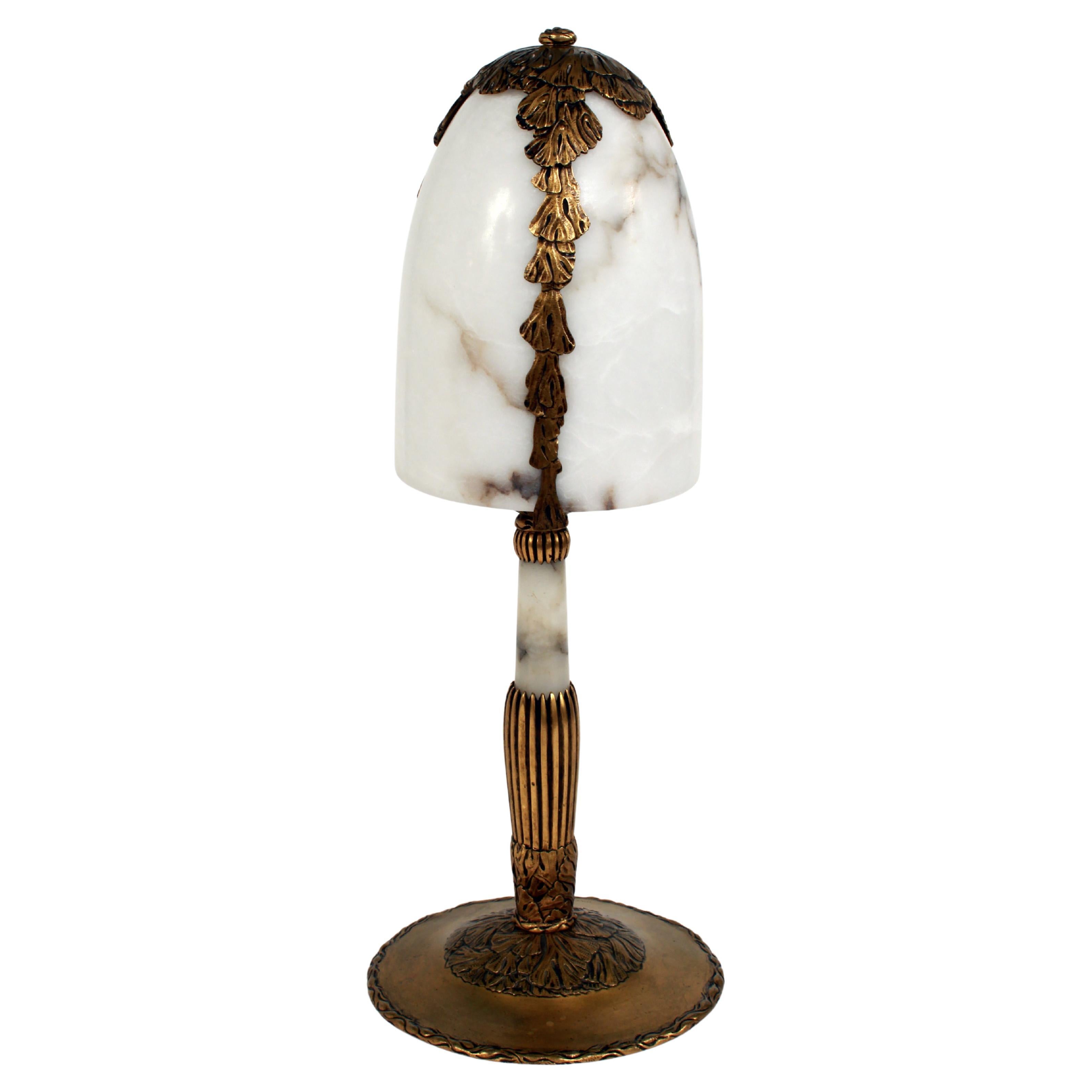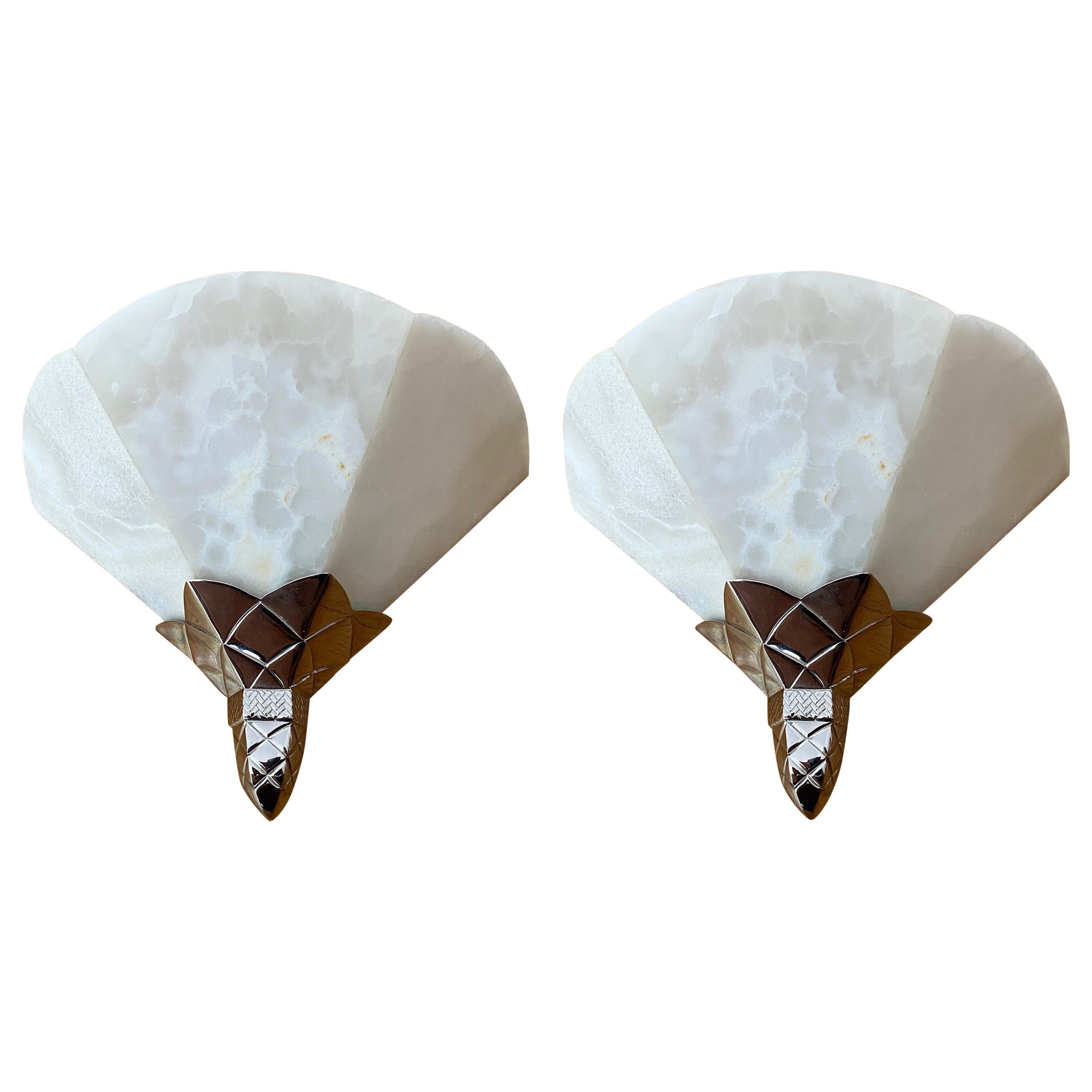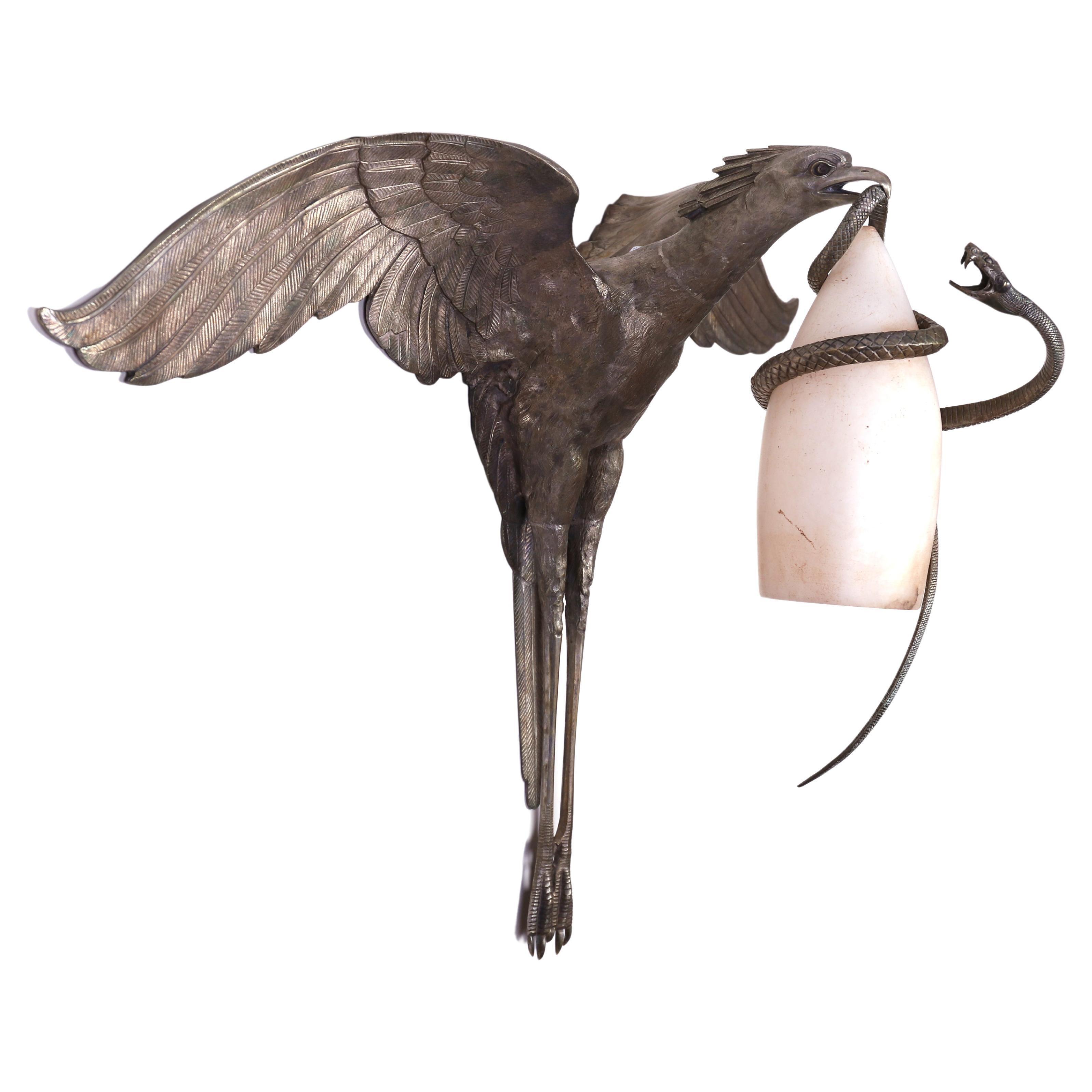Items Similar to Albert Cheuret Silvered Bronze and Alabaster "Tulip" Lamp
Want more images or videos?
Request additional images or videos from the seller
1 of 8
Albert Cheuret Silvered Bronze and Alabaster "Tulip" Lamp
About the Item
The innovative structure of Albert Cheuret's lamp mirrors a cluster of three white tulips emerging from a mound of earth. Cheuret fashioned his lamp as a trio of tulip flowers featuring intricately carved alabaster flowerheads. The use of alabaster, a material extensively employed by the Romans for intricately carved shades, is notable. Its translucent properties enabled it to transmit light when illuminated from within or when positioned against a window. Within the context of this lamp, Cheuret's choice of alabaster skillfully captures the delicate nature of a flower's petals.
Product Details:
Item #: EL-21415
Artist: Albert Cheuret
Country: France
Dimensions: 15" height, 6.5" diameter
Materials: Silvered Bronze, Alabaster
Signed: Albert Cheuret
Literature: Lumières, je pense à vous, exh. cat., Centre Georges Pompidou, Paris, 1985, p. 149, pl. 197
Macklowe Gallery Curator's Notes:
Albert Cheuret was born in 1884 in Paris. He studied sculpture with Jacques Perrin, professor at the Ecole des Beaux Arts in Paris (fine arts school), and with Georges Lemaire. The artist began his career in 1907 and set up his studio at 11 Avenue Franco-Russe, near the Champ de Mars. In 1908, he received 1st prize in the Ornamental Sculpture competition organized by the Réunion des fabricants de bronze (bronze manufacturers guild) founded in 1818. He exhibited regularly at the Salon of French Artists. He was an officer in the 1st engineering corps during WWI. Wounded twice, he was awarded Knight of the Legion of Honour in 1920. Albert Cheuret was also granted numerous commissions for commemorative structures, notably for the cemeteries of Montparnasse and Père Lachaise in Paris, as well as the war memorial for the city of Cannes. At the Universal Exhibition in Paris in 1925, Albert Cheuret rented a stall along the Alexandre III bridge and presented his famous light fixtures in bronze and alabaster, his favorite materials. He also exhibited clocks, animal figures, and furniture - tables, consoles, end tables - whose sculptural crafting attests to his talent as an artist.
- Creator:Albert Cheuret (Artist)
- Dimensions:Height: 15 in (38.1 cm)Diameter: 6.5 in (16.51 cm)
- Power Source:Plug-in
- Lampshade:Included
- Materials and Techniques:
- Place of Origin:
- Period:
- Date of Manufacture:1925
- Condition:
- Seller Location:New York, NY
- Reference Number:
About the Seller
4.8
Recognized Seller
These prestigious sellers are industry leaders and represent the highest echelon for item quality and design.
Established in 1971
1stDibs seller since 2010
44 sales on 1stDibs
Typical response time: 1 hour
- ShippingRetrieving quote...Ships From: New York, NY
- Return PolicyA return for this item may be initiated within 3 days of delivery.
More From This SellerView All
- Émile Gallé “Bats and Iris” Table LampBy Emile GalléLocated in New York, NYThis exquisite Galle bat lamp is crafted from three-color cameo glass, featuring a delicate lavender-hued shade adorned with a golden finial, held aloft by th...Category
Early 20th Century French Art Nouveau Table Lamps
MaterialsBronze
- Edgar Brandt and Daum “La Tentation” Table LampBy Edgar Brandt, DaumLocated in New York, NYA French Art Deco serpent lamp by Edgar Brandt and Daum titled “La Tentation”. The lamp features a rich brown, bronze Boa Python, almost completely vertically extended, wrapped aroun...Category
Early 20th Century French Art Deco Table Lamps
MaterialsWrought Iron
- Tiffany Studios New York Damascene Table LampBy Tiffany StudiosLocated in New York, NYThis delicately sized Tiffany Studios New York “Damascene” lamp is superbly colored in blood-orange and gold. Trails of blood orange glass were applied...Category
Early 20th Century American Art Nouveau Table Lamps
MaterialsBronze
- Tiffany Studios New York "Peony" Table LampBy Tiffany Studios, Louis Comfort TiffanyLocated in New York, NYTiffany’s “Peony” table lamp was a work grounded in naturalism but reaching for the divine. With a shade of resplendent blooms and a mosaic base evoking the hallowed ground of church floors, Tiffany’s peony lamp demonstrates his foundation in both Art nouveau and ecclesiastical art. To depict his multi-hued bouquet, Tiffany depicted two different cultivars, a Greek peony, and a Japanese peony. Tiffany used burgundy glass streaked with lapis to express the richness of the Greek Peony. Favored by neoclassical artists for their symmetry and simplicity, Tiffany featured the bloom in the architecture of his country estate. To represent the candy-striped Japanese peony Shima Nishiki, Tiffany used cream glass streaked with fuschia. The shade elegantly depicts different stages of growth from the bud, first bloom, peak bloom, to wilting. When peony petals wilt, their veins darken, and their form puckers. Tiffany’s glass selectors chose a stone textured glass called granite glass to express the wilting of the petals and their pronounced venation. The background and border of the shade is a golden amber, streaked with magenta and blue. The top-down perspective of the peony with a dirt background was a type of painting called “Rasenstück”, a detailed study of a piece of turf. The crux of the Rasenstück was the elevation of the humble. Popularized in the nineteenth century by the American Pre-Raphaelites, the movement believed in the idea of "truth to nature". The principle encouraged painters to capture the natural world as truthfully as possible, not romanticizing what they saw. In these nature studies, painters depicted flowers and trees in the soil from which they grew. While sublime on its own, the shade and base taken together paint a picture of Tiffany’s Japanese garden. Peonies imported from the far east bordered serene ponds. A frieze of turtleback tiles hypnotizes the viewers with its scarlet glow, evoking the red flash of a sunset, as seen through a field of cattails, rendered in bronze. Below it, the row of cat tails blends into a mosaic of red, yellow, and green glass. While Tiffany’s chief designer Clara Driscoll is most famous for her naturalistic lamp designs, the bread and butter of Tiffany Studios was its ecclesiastical department. Red, yellow, and green colorways were widely used in the depiction of Baroque angels, whose wings were modeled after birds of paradise. As hunters removed their legs upon sale, many believed they neither ate nor drank, and instead floated ethereally like angels. A lamp such as this epitomizes Tiffany’s understanding of his artistic vision in the context of the entire history of artistic expression. Since falling in love with glass at age twelve in the cathedrals of Chartres, light itself became a representation of divinity. A contemporary critic described Tiffany’s mosaics...Category
Early 20th Century American Table Lamps
MaterialsBronze, Lead
- Tiffany Studios New York "Wisteria" Table LampBy Tiffany Studios, Louis Comfort TiffanyLocated in New York, NYThis remarkable Tiffany Studios New York "Wisteria" table lamp is a very fine and unusually rare lamp, composed of a palette of wisteria blossoms in shades of blue, green, cream and white that cascade down the shade to an irregular border. The blossoms are surrounded by abundant leaves in varying shades of green and are delicately interspersed with "confetti" glass, lending them added three-dimensionality. The shade has a latticework top, portraying the branches and stems of a wisteria vine. The base, designed specifically to hold the shade, is also embellished with vegetal, vine-like properties. Product Details: Item #: L-20375 Artist: Tiffany Studios New York Country: United States Circa: 1902 Dimensions: 18.5" diameter, 27" height Materials: Leaded glass, Bronze Shade Signed: Interior of shade crown impressed 1073 and 13; underside of shade mounting post impressed 1073 and 13 Base Signed: ''Tiffany Studios New York 1073"; top of tree trunk column impressed 13 Literature: Robert Koch, Louis C. Tiffany: Rebel in Glass, New York, 1964, pl. v Dr. Egon Neustadt, The Lamps of Tiffany, New York, 1970, pp. 215-220 Alastair Duncan, Tiffany At Auction, New York, 1981, pp. 89, no. 238 and 148, no. 391 William Feldstein, Jr. and Alastair Duncan, The Lamps of Tiffany Studios, New York, 1983, p. 37 Robert Koch, Louis C. Tiffany's Glass, Bronzes, Lamps: A Complete Collector's Guide, New York, 1989, p. 131 Robert Koch, Louis C. Tiffany: The Collected Works of Robert Koch, Atglen, PA, 2001, pp. 74, 242 and 284 Alastair Duncan, Louis C. Tiffany: The Garden Museum Collection, Woodbridge, Suffolk, 2004, pp. 292-293 Martin Eidelberg, Alice Cooney Frelinghuysen, Nancy A. McClelland and Lars Rachen, The Lamps of Louis Comfort Tiffany, New York, 2005, p. 107 Alastair Duncan, Tiffany Lamps and Metalware, Woodbridge, Suffolk, 2007, p. 67, no. 254 Martin Eidelberg, Nina Gray and Margaret K. Hofer, A New Light on Tiffany: Clara Driscoll and the Tiffany Girls...Category
Early 20th Century American Table Lamps
MaterialsBronze, Lead
- Tiffany Studios New York "Damascene Lighthouse" Desk LampBy Tiffany StudiosLocated in New York, NYThis Tiffany Studios New York "Lighthouse" desk lamp features a bell-shaped iridescent green Favrile “Damascene” shade, suspended from a two-posted patinated bronze swing-top base, f...Category
Early 20th Century American Art Nouveau Table Lamps
MaterialsBronze
You May Also Like
- Tulip Form Gilt Bronze and Alabaster Stone Lamps by Albert Cheuret (1884-1966)By Albert CheuretLocated in New York, USOur gilt table lamps in the form of tulips by Albert Cheuret (1884-1966) in gilt bronze with carved alabaster flower petals. 14 3/4 inches tall and e...Category
Mid-20th Century French Art Deco Table Lamps
MaterialsAlabaster, Bronze
- Art Deco Table Lamp by Albert CheuretBy Albert CheuretLocated in Miami, FLFabulous French Art Deco table lamp by Albert Cheuret with an Alabaster Shade, Gilded Bronze shaft and details.Category
Vintage 1920s French Art Deco Table Lamps
MaterialsAlabaster, Bronze
- Albert Cheuret, Pair of Silver and Alabaster Wall SconcesBy Albert CheuretLocated in Fairfax, VAPair of Art Deco silver on bronze, cone shape alabaster shade wall sconces. By Albert Cheuret (French, 1884–1966).Category
Vintage 1930s French Art Deco Wall Lights and Sconces
MaterialsAlabaster, Bronze
- After Albert Cheuret Wall SconcesBy Albert CheuretLocated in Bridgewater, CTChromed metal and alabaster wall sconces after Albert Cheuret. electrified, UL listed.Category
Late 20th Century American Art Deco Wall Lights and Sconces
MaterialsAlabaster, Metal
- Albert Cheuret Rare and Important Pair of "Serpentaire" SconcesBy Albert CheuretLocated in Mondorf les Bains, LUAlbert Cheuret (1884-1966) Rare and important pair of "Serpentaire" sconces in silvered bronze Representing the raptor with wings spread in full flight holding a snake in its beak,...Category
Vintage 1920s Luxembourgish Art Deco Wall Lights and Sconces
MaterialsBronze
- Unique French Art Deco Alabaster Sconces 1920s Gilt Bronze Ruhlmann Cheuret EraBy Émile-Jacques Ruhlmann, Albert Cheuret, Jules LeleuLocated in Nierstein am Rhein, DERare pair French gilt bronze and unique carved creamy white beige or ivory color alabaster half bowl sconces with beautiful charcoal mineral veining in black...Category
Vintage 1920s French Art Deco Wall Lights and Sconces
MaterialsAlabaster, Brass, Bronze





